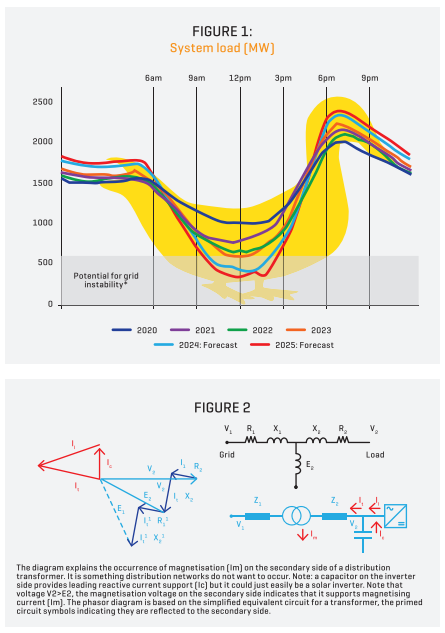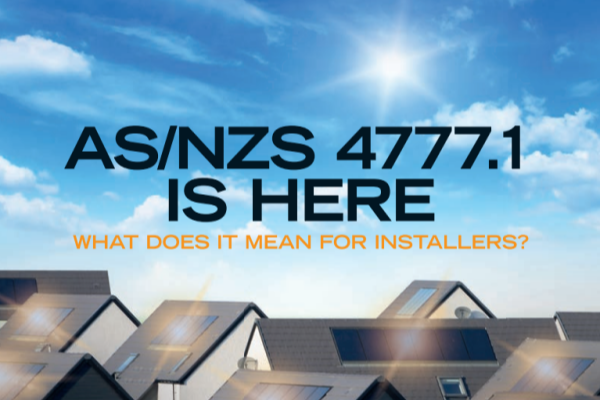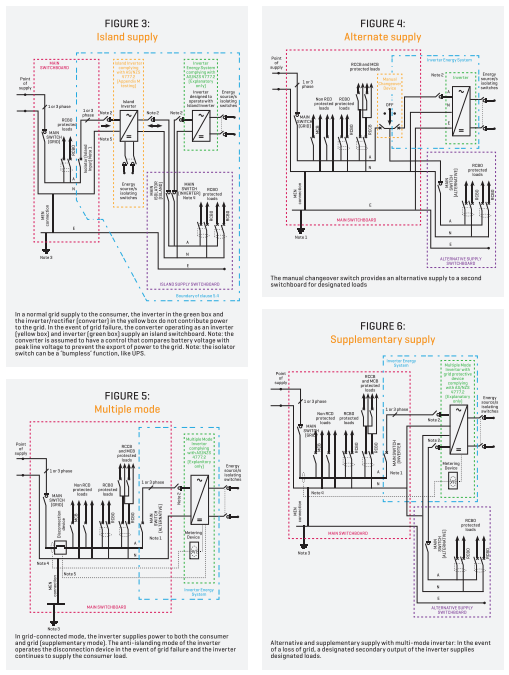AS/NZS 4777: The disrupter of distribution networks?
The latest solar inverter installation standard has been released. Phil Kreveld looks at what the changes are and what it means for electricians.
That question won’t have been resolved—at least not completely by the time you’ve waded through the major changes in the 2024 version of AS/NZS 4777.1 wiring standard for solar inverters. Even so, pay attention as it will have come into force by the time you read this article. As to being a disruptor in distribution networks—well, it is a harbinger of significant changes along with the IEC 2030.5 communication standard for inverters which is already being applied in South Australia.
ADVERTISEMENT
Have you ever wondered why with the continuing growth in aggregate rooftop solar capacity, taking care of daylight-hours domestic and commercial consumption (see Figure 1, the South Australian Duck Curve), we really must string up more and more transmission lines to remote, renewable energy zones and pile on hundreds of gigawatts in solar and wind to hit the 2030 (82% of renewable capacity)?
You are of all people, well aware that the growth in domestic battery installations can shift the Duck Curve into the hours of darkness.
So, although we concentrate here on the standard, and its implications for obvious changes to EV charging and vehicle-to-grid (V2G), keep in mind that by rights, AS/NZS 4777 ought to be a highly dynamic standard with lots of future revisions.
Here’s one for the suggestion box: Make distribution networks independent because Electrical Engineering 101 says that you should keep your generator of electrical power next to your load. That would for sure make for more changes to AS/NZS 4777.2 as well.
By way of lead-in, your solar customers are entitled to be confused about what their inverters can and can’t do. The new wiring standard and the potential advantages for offline operation should be explained for new or changes to existing installations. The important difference is in the ability of their solar inverter(s) to operate with and without the presence of line voltage.
In line voltage-connected mode, a solar inverter operates in grid-following mode, i.e., the line voltage is followed accurately by the inverter’s phase-locked loop (PLL) and the inverter current output, follows the voltage sinewave, either in phase or with a fixed phase angle difference (the latter is used for so-called ‘reactive current voltage support’).
In offline mode, the inverter has to generate its own AC voltage, i.e., it is operating in ‘voltage forming mode’. There is no rocket science involved because inverters for use on boats and caravans and lots of other applications have done so for years. You’ll note that in the case of offline operation, the new standard does not require adherence to AS/NZS 4777.2.
By way of explanation, inverters that comply with AS/NZS 4777.2 utilise AC current generated by sinewave pulse width modulation (SWMP). That technique is not required for offline operation although there are inverters that use the same technique for offline or online. The important difference between SWPM and offline operation is that for the latter, a very simple switching mode for the power transistors can be used (unless filters are employed) the AC voltage and current have a lot of harmonics.
Note that a horrible-looking AC voltage can still provide a halfway reasonable-looking near-sinewave current, by virtue of the ‘filtering’ by the load, for example, workshop motors for angle grinders, drills etc. In online operations, network operators are anxious about distortions (harmonics) because they can interfere with power line (low frequency) communication used for timed load switching like hot water supply.
Part 5 of the AS/NZS 4777.1.2024 standard indicates much more flexibility in solar installations in addition to the plain vanilla, standard connection. The important variation is the opportunity to install an isolator switch, taking the inverter offline. But there’s more as indicated by the circuit diagrams and descriptions.
The new standard is significant in that it lays the foundation for V2G, as well as grid support although that in itself is not new. As to the future of net power export into networks, that’s anybody’s guess. With the growth of larger rating solar, the whole messy business of reverse power flow pops up. Community batteries are there to soak up excess power to prevent voltage rise but there are nasty problems with transformers.
We could just forget about this as a side issue but it is part of ‘professional development’, and a problem, distribution networks do not have a neat answer for. A looming problem is reverse power flow in kiosk pole-mounted transformer. You might conclude that it is of no importance on which side you are providing the magnetising current. If you do it on the secondary of, say an 11kV/415V transformer, overheating of the core and harmonics can occur. This as well as having to reconductor large sections of the low voltage network are the reasons why solar inverters are being remotely switched off in South Australia.
It is understandable that Aussie distribution grids are heading into troublesome times. Rather than facing up to the need for a comprehensive engineering review of the complete electricity system, nationally we have taken the view that distribution networks should remain a one-way street. Yet mums and dads and businesses are piling on solar capacity to reduce their cost of electricity.
In the next section, the important changes have been laid out as diagrams. Obviously, the only official document is the actual standard, and the diagrams should be taken as indicative.
Part 5 of the draft standard outlines the following schemes of operation in addition to the single output inverter:
- Multiple mode inverter with grid connection and alternative supply connection
- Island supply inverter and supplementary supply inverter
- Portable or vehicle-installed inverter, for example, AC output of an EV
The draft AS/NZS 4777.1:2024 standard comes at a critical time in Australia’s transition to renewables because of increasing reliance on grid support from distribution network installed inverters, for example, AEMO’s fast frequency control ancillary service and virtual private power plant.
The final comment on the draft standard has closed and contractors should become familiar with the proposed changes.
-
ADVERTISEMENT
-
ADVERTISEMENT



